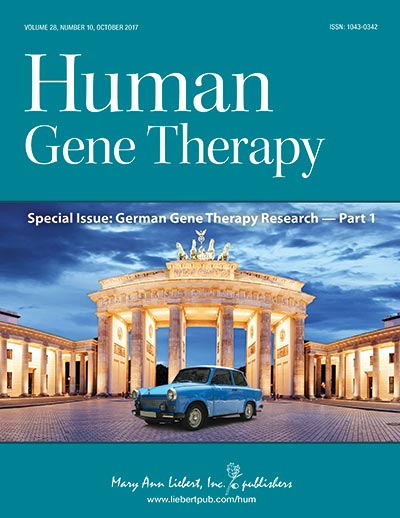For Immediate Release
Researchers Use Mini Form of Replacement Gene to Delay Photoreceptor Degeneration in Leber Congenital Amaurosis
Contact: Kathryn Ryan
914-740-2250
kryan@liebertpub.com

New Rochelle, NY, October 5, 2017—A new study demonstrates success in using a shortened form of the CEP290 gene for gene therapy in a mouse model of Leber congenital amaurosis type 10 (LCA10), a retinal degenerative disorder that causes childhood blindness. The large size of the full-length gene has proven difficult to package into the adeno-associated virus (AAV) delivery vectors commonly used in gene therapy, but use of the truncated gene led to significant improvement in photoreceptor survival, morphology, and function, as reported in an article published in Human Gene Therapy, a peer-reviewed journal from Mary Ann Liebert, Inc., publishers. The article is available free on the Human Gene Therapy website.
Wei Zhang, Linjing Li, Qin Su, Guangping Gao, and Hemant Khanna, University of Massachusetts Medical School, Worcester, describe their work in the article entitled "Gene Therapy Using a miniCEP290 Fragment Delays Photoreceptor Degeneration in a Mouse Model of Leber Congenital Amaurosis." The researchers present not only a potential approach for designing a suitable gene therapeutic strategy to overcome the CEP290 gene mutation underlying LCA, but also highlight the use of therapeutic minigenes as a viable option for delivering large genes to treat other diseases.
“The dramatic clinical results observed in patients treated with AAV-RPE65 vectors with LCA2 has raised expectations that similar approaches could be used to treat many different single gene disorders of the retina,” says Editor-in-Chief Terence R. Flotte, MD, Celia and Isaac Haidak Professor of Medical Education and Dean, Provost, and Executive Deputy Chancellor, University of Massachusetts Medical School, Worcester, MA. “Overcoming the limitation of the packaging capacity of the AAV particle for this large gene is a critical step in the development of LCA10 gene therapy.”
Research reported in this publication was supported by the National Institutes of Health under Award Number EY022372, 1R01NS076991-01, P01AI100263-01, and 1 P01HL131471-01. The content is solely the responsibility of the authors and does not necessarily represent the official views of the National Institutes of Health.
About the Journal
Human Gene Therapy, the Official Journal of the European Society of Gene and Cell Therapy, British Society for Gene and Cell Therapy, French Society of Cell and Gene Therapy, German Society of Gene Therapy, and five other gene therapy societies, is an authoritative peer-reviewed journal published monthly in print and online. Led by Editor-in-Chief Terence R. Flotte, MD, Celia and Isaac Haidak Professor of Medical Education and Dean, Provost, and Executive Deputy Chancellor, University of Massachusetts Medical School, Human Gene Therapy presents reports on the transfer and expression of genes in mammals, including humans. Related topics include improvements in vector development, delivery systems, and animal models, particularly in the areas of cancer, heart disease, viral disease, genetic disease, and neurological disease, as well as ethical, legal, and regulatory issues related to the gene transfer in humans. Its companion journals, Human Gene Therapy Methods, published bimonthly and focused on the application of gene therapy to product testing and development, and Human Gene Therapy Clinical Development, published quarterly, features data relevant to the regulatory review and commercial development of cell and gene therapy products. Tables of contents for all three publications and a free sample issue may be viewed on the Human Gene Therapy website.
About the Publisher
Mary Ann Liebert, Inc., publishers is a privately held, fully integrated media company known for establishing authoritative peer-reviewed journals in many promising areas of science and biomedical research, including Nucleic Acid Therapeutics, Tissue Engineering, Stem Cells and Development, and Cellular Reprogramming. Its biotechnology trade magazine, GEN (Genetic Engineering & Biotechnology News), was the first in its field and is today the industry’s most widely read publication worldwide. A complete list of the firm’s 80 journals, books, and newsmagazines is available on the Mary Ann Liebert, Inc., publishers website.
Mary Ann Liebert, Inc. 140 Huguenot St., New Rochelle, NY 10801-5215 www.liebertpub.com
Phone: (914) 740-2100 (800) M-LIEBERT Fax: (914) 740-2101